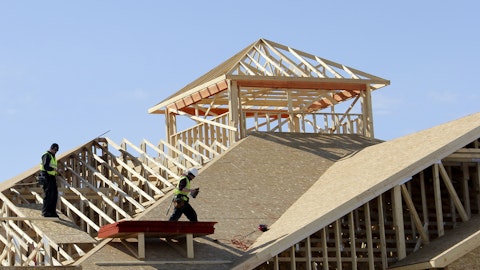FirstService Corporation (NASDAQ:FSV) Q1 2024 Earnings Call Transcript April 24, 2024
FirstService Corporation beats earnings expectations. Reported EPS is $0.67, expectations were $0.66. FSV isn’t one of the 30 most popular stocks among hedge funds at the end of the third quarter (see the details here).
Operator: Welcome to the First Quarter Investor’s Conference Call. Today’s call is being recorded. Legal counsel requires us to advise that the discussion scheduled to take place today may contain forward-looking statements that involve known and unknown risks and uncertainties. Actual results may be materially different from any future results, performance or achievements contemplated in the forward-looking statements. Additional information concerning factors that could cause actual results to materially differ from those in the forward-looking statements is contained in the company’s annual information form as filed with the Canadian Securities Administrator’s and in the company’s annual report on the Form 40-F as filed with the U.S. Securities and Exchange Commission. As a reminder, today’s call is being recorded. Today is April 24, 2024. I would like to turn the call over to Chief Executive Officer, Mr. Scott Patterson. Please go ahead.
Scott Patterson: Thank you, Justin. Good morning, everyone, and thank you for joining our Q1 conference call. Jeremy Rakusin is on with me, and together we’ll walk you through the results we released this morning that were generally right in line with our internal expectations. Total revenues were up 14% over the prior year, driven entirely by acquisitions, primarily our acquisition of Roofing Corp of America in December. Similar to our Q4, organic growth in the first quarter was nil, due to very strong revenues in last year’s Q1 from hurricanes Ian and Fiona. EBITDA of the quarter was up incrementally to $83 million from $82 million in the prior year. The results reflect trends and themes that we saw in our Q4 results and discussed in our year-end call.
Jeremy will take you through margin detail and the balance sheet in his comments. Looking at our division of results, First Service residential revenues were up 11%, 8% organically and generally consistent with what we’ve seen from this division over the last year. Organic revenue growth was driven from net new contract wins. During the quarter, we announced the acquisition of Florida-based Rizzetta & Company. Rizzetta provides consulting and management services to HOAs in Florida and also to community development districts, which are known as CDDs. A CDD is a special purpose local government that exists in Florida and also certain other states including Georgia, Texas, and California. The CDD structure provides the ability to finance new development with tax-free municipal bonds.
Rizzetta brings up particular expertise in CDD management and introduces a new service offering for us that we believe we can grow within Florida and also to other states. Looking forward at First Service residential for the balance of the year, we’re reiterating our expectation for high-single-digit level growth with organic growth easing back towards the mid-single-digit range. Moving on to First Service brands, revenues for the quarter were up 16%, driven primarily by the acquisition of Roofing Corp of America, but also several tuck-unders within our restoration and fire safety segments. Organically, revenues were down 6% versus the prior year with gains at Century Fire offset by declines at our restoration brands, very similar to our organic results in Q4.
Let me give you a high-level review of each segment. I’ll start with restoration, which includes our results from Paul Davis and FirstOnSite. Revenues for the quarter were down by almost 10% and organically were off 15% versus a very strong Q1 in the prior year that was up 30% versus 2022. Similar to Q4, we continued to experience mild weather patterns across North America during the quarter. Residential and commercial claim activity was well off what we would expect on average. Revenues generated during the quarter from our remaining Hurricane Ian backlog amounted to about $10 million, compared to over $80 million from Ian, Elliott, and Fiona in our prior Q1. During the quarter, we were pleased to report the acquisition of Atlanta-based All Restoration Solutions by FirstOnSite.
All Restoration has a strong position in the Georgia market with four branches and a blue-chip client base. The addition brings to us a strong leadership team and is very complimentary in terms of geographic footprint and customer serve. We’re excited about our opportunity in the Atlanta market and throughout Georgia. Looking forward to Q2 and Restoration, we expect revenues to continue at approximately the same level sequentially, which would again result in a 10% revenue decline from Q2 of last year. I will now touch on our new roofing segment, which delivered a Q1 in line with our expectation. Q1 will generally be a modestly weaker quarter for us in roofing, as it is in painting, due to winter weather in certain of our regions and the inability to consistently work on exteriors.
We had budgeted for this during our due diligence, and it rolled in as expected. Looking forward, we expect sequentially stronger results for the balance of the year. Now to our home improvement brands, which as a group were up modestly year-over-year, low-single-digit growth in total and flat organically. We’re pleased with our results given current market conditions with home improvement spending down across North America. By matching last year’s revenue levels, we are taking share across each of our brands. Lead activity remains sluggish, and we don’t expect it to improve for the balance of the year unless we see some rate cuts. We may see some modest fluctuation quarter-to-quarter, but otherwise we are confirming our expectation to end the year slightly up in home improvement.

And finally, a look at Century Fire, which had another strong quarter with low-double-digit organic growth, really a continuation sequentially of the strength we saw all last year with Century. Looking forward to the balance of 2024, we’re confirming the expectations we laid out in our year-end conference call. That is continued strength at Century with year-over-year growth trending to high-single-digit based on increasingly tough comp quarters upcoming. I will now hand over to Jeremy.
Jeremy Rakusin: Thank you, Scott. Good morning, everyone. I’ll start by summarizing our first quarter results on a consolidated basis, which track closely to the indicators we provided during our most recent 2023 year-end earnings call in early February. For the quarter, we reported revenues of $1.16 billion, a 14% increase over the $1.02 billion for Q1 ‘23. Adjusted EBITDA was $83.4 million, up a modest 2% year-over-year, with a 7.2% margin for the quarter, compared to a margin of 8.1% in the prior year quarter. And our adjusted EPS was $0.67, compared to $0.85 per share in the prior year. Our adjustments to operating earnings and GAAP EPS and arriving at adjusted EBITDA and adjusted EPS respectively are consistent with our approach in prior periods.
I’ll now summarize the segmented results for our two divisions. First Service residential generated revenues of $496 million, up 11% over last year’s first quarter, while EBITDA was $35.6 million and 11% increase, as well over the prior year. The EBITDA margin for the division came in at 7.2% matching the prior year. During the balance of the year, margins will increase sequentially as our seasonal amenity operations ramp up. And as previously indicated, the margins will remain roughly in line with prior levels. Now to First Service brands where we reported revenues of $662 million for the current quarter, up 16% over last year’s Q1. Our EBITDA for the division was $55.5 million, a 1% increase versus the prior year quarter, and the margin was 8.4% down 120 basis points versus last year’s 9.6% level.
As Scott noted, our restoration operations faced a headwind of $80 million in prior year storm-related revenues, and that was the principal driver behind the margin decline for the division. We also incurred some margin compression in our Home Services segment as the businesses implemented increased promotions and marketing spending to preserve their top line performance. Century Fire Protection continued to deliver strong margins, and our new Roofing Corp of America investment performed in line with our expectations. Wrapping up our P&L review with items below the operating divisions, our corporate costs were up significantly over prior year. Most of the $3 million increase was due to the negative non-cash effect of foreign exchange movements during the quarter.
Higher interest costs also reduced our earnings per share as in prior quarters. In this particular Q1, it was up almost double the level of the prior year with a negative impact of $0.13 per share. Finally, our consolidated tax rate increased from 26% last year to 29% in the current quarter, which is right in line with our tax rate expectations for full-year 2024. Turning to our consolidated cash flow, we generated $56 million of cash flow from operations before working capital changes. Q1 is our seasonal trough cash flow period when some of our businesses have lower revenues and higher operating expenses and working capital requirements as they invest for the balance of the year. We netted $10 million of cash flow after these operational working capital investments, excluding almost $20 million for recent acquisition-related earn-out payments.
Capital expenditures during the quarter were $25 million, up modestly over the prior year spending level, and tracking to our CapEx guidance for the full-year of roughly $115 million. During the quarter, we also deployed just over $30 million of capital towards the two tuck-under acquisitions, which Scott referenced. Our teams have an active tuck-under prospect pipeline across several of our brands, including property management, restoration, roofing and fire protection as we look to augment our organic growth with acquisitions in these business lines. Concluding the reported financials commentary is our balance sheet. We closed the quarter with net debt at a little under $1.1 billion, an increase of $80 million since year-end, reflective of the cash flow movements I just walked through.
Our leverage, as measured by net debt to trend 12 months EBITDA, sits at 2.3 times, increasing modestly over the 2.1 times level at year-end, as is relatively typical after our seasonally lowest Q1. Liquidity, including our cash and undrawn bank revolver balance is approximately $360 million. The strength and flexibility of our balance sheet remains a cornerstone of our conservative approach to driving further growth. Looking forward, in the upcoming second quarter, we are forecasting consolidated revenue growth similar to Q1 in the low-teens percentage range. EBITDA is expected to increase at a mid-single-digit growth rate, with residential division margins relatively flat, while brands’ division margins will remain down year-over-year in the face of continued tough weather-driven restoration prior year comparisons.
With the reported first quarter and pending Q2 lining up with our expectations, our outlook for the 2024 full-year, which are provided with our 2023 year-end results in February, remains on track. That concludes our prepared comments. Operator, could you please open up the call to questions now? Thank you very much.
See also 10 Best Healthcare Stocks to Buy Under $20 and 15 Fastest Declining Countries in Asia.
Q&A Session
Follow Firstservice Corp (NASDAQ:FSV)
Follow Firstservice Corp (NASDAQ:FSV)
Operator: Thank you. [Operator Instructions] And our first question comes from Stephen MacLeod from BMO Capital Markets. Your line is now open.
Stephen MacLeod: Great. Thank you. Good morning, guys.
Scott Patterson: Hi, Steve.
Stephen MacLeod: Hi, good morning. Just a couple of questions that I wanted to ask here. Just firstly, with respect to the restoration business, could you just remind us how much weather you had in last year’s Q2 or how much weather related revenues? I seem to recall back from my notes that it was in the $30 million range, is that right?
Scott Patterson: Correct. It was, Stephen, $30 million from storms. The other thing that we benefited from in Q2 last year was just general weather, widespread weather that is certainly greater than what we’re seeing today. And we had a couple of particularly large losses at this time last year. We’re in the business of large loss at FirstOnSite. And we consistently have large losses in our backlog. But year-over-year, that level of activity is down just to because of the size of a couple of particular jobs last year.
Stephen MacLeod: Oh, okay. Okay, no, that’s helpful. And I guess just if I thought through the year-over-year impacts from weather in Q1 versus the year-over-year impacts from weather in Q2, would you expect margins to be down at a similar magnitude in Q2 on a year-over-year basis or a little bit less, because the large storm activity was a bit less robust than it was in Q1 last year?
Jeremy Rakusin: It could be a little less, Stephen, but I think the headline name storms, you’re right, is a little less of a headwind in Q2, but as Scott just mentioned, because of some other large losses, it’s not going to necessarily be particularly keyed right to that differential between the $80 million headwind in Q1 and $30 million in Q2. But we will be down and it’s reflective of my comments on margins in general for Q2 being down.
Stephen MacLeod: Right, okay. Okay, no, that’s helpful. And then just on the residential business, you had another nice quarter of strong organic growth. I know you’re guiding to that kind of trending back down to the mid-single-digit range? Can you just talk a little bit about sort of what other factors you’re seeing impacting organic growth beyond new contract wins? I mean you’re still seeing conversions to outsource management and I guess if you’ve seen that sort of new community activity beginning to tail off a little bit?
Scott Patterson: I mean we’re definitely seeing, continue to see new development and conversions to from self-management to professional management. The — there’s a couple of things that are causing us to see a normalization in our net new contract wins back to historical levels. You know, really for the last nine months, community budgets have been under considerable pressure from — primarily from accelerating insurance premiums. But also in Florida from legislation that requires cash reserves for maintenance and repairs to be funded. This is all post-surfside legislation, surfside being the condo collapse in June of ‘21. In the past, boards could choose to defer maintenance or reduce cash reserves and it’s no longer possible.
And the combination of insurance and some recently passed legislation is causing the boards to look very, very closely at cash flow and all expense items, and it’s putting pressure on management fees. Really nothing new for us. I mean, we’re always looking to find that balance between margin and organic growth. And if we’re not able to generate an appropriate margin on a particular community contract, we’re allocate our resources elsewhere. The other thing that’s happening, the trend for us is our pool maintenance and management business, which is part of our amenity service offering along with the management of fitness areas and spas, concierges, events and so on. We’ve offered pool services for years and years to our managed communities, but also to country clubs and multi-family.
The pool business is very seasonal, and we’re looking to maintain this business, but we’re not focused on growing it. It’s become very, very difficult to staff with lifeguards and maintenance pool tax. And so we’re being very careful and strategic about the business we take on and how we allocate our resources. And this will have the effect of diluting our growth in this division, particularly in the peak seasonal quarters, so Q2 and Q3. And so we expect to see some of that this year.
Stephen MacLeod: Okay, thanks Scott, that’s helpful color. I guess as I think about those factors specifically and maybe turning the page to 2025, do you expect to continue to be able to drive that historical mid-single-digit organic growth rate in the residential business, notwithstanding those items you just talked about?
Scott Patterson: Yes, yes…
Stephen MacLeod: Or including those items you just talked about?
Scott Patterson: Yes, we just think at the eight, nine, 10 level, we see that, as we’ve said for a few quarters now, we see that organic growth start to temper and settling closer to our historical average.
Stephen MacLeod: Okay, that makes sense. Great. Thanks, guys. Appreciate it.
Operator: And thank you. And one moment for our next question. And our next question comes from Stephen Sheldon from William Blair. Your line is now open.
Stephen Sheldon: Hey, good morning. Thanks for taking my questions. I wanted to start in residential and Scott you kind of talked about this a little bit in your prepared remarks. How are you thinking about the opportunity to gain market share with some of these larger CDDs now that you own Rizzetta? Are you expecting this to be an outsized area of growth in residential and potentially become a larger chunk of the portfolio as you think about the coming years?



